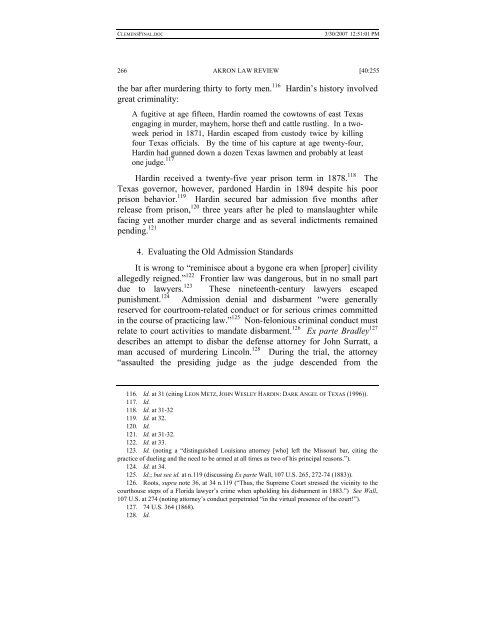Facing the Klieg Lights: Understanding the "Good Moral Character"
Facing the Klieg Lights: Understanding the "Good Moral Character"
Facing the Klieg Lights: Understanding the "Good Moral Character"
Create successful ePaper yourself
Turn your PDF publications into a flip-book with our unique Google optimized e-Paper software.
CLEMENSFINAL.DOC<br />
3/30/2007 12:51:01 PM<br />
266 AKRON LAW REVIEW [40:255<br />
<strong>the</strong> bar after murdering thirty to forty men. 116 Hardin’s history involved<br />
great criminality:<br />
A fugitive at age fifteen, Hardin roamed <strong>the</strong> cowtowns of east Texas<br />
engaging in murder, mayhem, horse <strong>the</strong>ft and cattle rustling. In a twoweek<br />
period in 1871, Hardin escaped from custody twice by killing<br />
four Texas officials. By <strong>the</strong> time of his capture at age twenty-four,<br />
Hardin had gunned down a dozen Texas lawmen and probably at least<br />
one judge. 117<br />
Hardin received a twenty-five year prison term in 1878. 118 The<br />
Texas governor, however, pardoned Hardin in 1894 despite his poor<br />
prison behavior. 119 Hardin secured bar admission five months after<br />
release from prison, 120 three years after he pled to manslaughter while<br />
facing yet ano<strong>the</strong>r murder charge and as several indictments remained<br />
pending. 121<br />
4. Evaluating <strong>the</strong> Old Admission Standards<br />
It is wrong to “reminisce about a bygone era when [proper] civility<br />
allegedly reigned.” 122 Frontier law was dangerous, but in no small part<br />
due to lawyers. 123 These nineteenth-century lawyers escaped<br />
punishment. 124 Admission denial and disbarment “were generally<br />
reserved for courtroom-related conduct or for serious crimes committed<br />
in <strong>the</strong> course of practicing law.” 125 Non-felonious criminal conduct must<br />
relate to court activities to mandate disbarment. 126 Ex parte Bradley 127<br />
describes an attempt to disbar <strong>the</strong> defense attorney for John Surratt, a<br />
man accused of murdering Lincoln. 128 During <strong>the</strong> trial, <strong>the</strong> attorney<br />
“assaulted <strong>the</strong> presiding judge as <strong>the</strong> judge descended from <strong>the</strong><br />
116. Id. at 31 (citing LEON METZ, JOHN WESLEY HARDIN: DARK ANGEL OF TEXAS (1996)).<br />
117. Id.<br />
118. Id. at 31-32<br />
119. Id. at 32.<br />
120. Id.<br />
121. Id. at 31-32.<br />
122. Id. at 33.<br />
123. Id. (noting a “distinguished Louisiana attorney [who] left <strong>the</strong> Missouri bar, citing <strong>the</strong><br />
practice of dueling and <strong>the</strong> need to be armed at all times as two of his principal reasons.”).<br />
124. Id. at 34.<br />
125. Id.; but see id. at n.119 (discussing Ex parte Wall, 107 U.S. 265, 272-74 (1883)).<br />
126. Roots, supra note 36, at 34 n.119 (“Thus, <strong>the</strong> Supreme Court stressed <strong>the</strong> vicinity to <strong>the</strong><br />
courthouse steps of a Florida lawyer’s crime when upholding his disbarment in 1883.”) See Wall,<br />
107 U.S. at 274 (noting attorney’s conduct perpetrated “in <strong>the</strong> virtual presence of <strong>the</strong> court!”).<br />
127. 74 U.S. 364 (1868).<br />
128. Id.
















